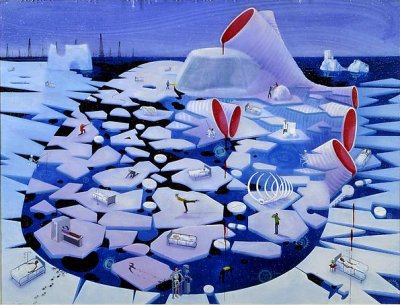Andrew Solomon on Frank Moore

Photo: Rebecca Moore.
The whole time I knew Frank Moore, he was dying; but this made his actual death, at the age of forty-eight, even more shocking than it would otherwise have been. Frank’s characteristic state of hovering transition seemed permanent: As clearly as I believed that Frank would never be well, I believed that he would never die. He came so close to dying so many times and always managed to pull back: Deathbeds were places he visited the way the rest of us visit sleep. Like Evel Knievel, he stayed alive against the odds, almost ostentatiously, as though he believed death could be defied through pure bullishness. Frank had AIDS for fifteen years, survived multiple cancers, endured experimental bone marrow replacement therapy, tried drugs that never made it to market and drugs he helped bring to market, fought off more opportunistic infections than one knew there could be opportunities for, built death into his life without sacrificing his resilient vitality. Though he was eventually consumed by his illness (he died April 21), his legacy is not that ultimate demise but the long survival that preceded it.
Both in his life and in his work, Frank harnessed outrage as an engine of creation and kept bitterness at bay. His work, usually about things going wrong in the world, is horrifying and nightmarish, upsetting and sad. And yet, despite their dark warnings, these paintings convey hope, an optimism about art itself: Frank believed that he could help the world along by depicting the dangers that beset it. The work is sinister and terrifying in part because it is so elegantly executed, and his trademark magic realism became ever more sophisticated as he grew older. Frank’s attention to detail-the homemade frames, for example-gives even his most dire paintings a quality of love. And there is always wit: a friendly bird to catch your eye in the corner, a lit cigarette glowing comfortably as it sprouts from a milkweed plant, a lurid figure of Donatella Versace in a commission for Gianni.

Frank Moore, Hospital, 1992.
In his mature work, Frank’s twin concerns were AIDS and the destruction of the environment. In the AIDS pieces, an iceberg in the shape of a human heart breaks apart, its valves bleeding (Hospital, 1992); or the whole earth has turned into a surrealist landscape of medical waste, through which Dr. JeanClaude Chermann, a codiscoverer of HIV, strolls with a retinue of white lab rats (Wizard, 1994); or a Norman Rockwell Thanksgiving is marred because the presentation turkey has turned into a platter of pills, syringes, and vials (Freedom to Share, 1994); or, more optimistically, a hospital bed floats in a wide sea, the patient hooked up to an IV, while a lighthouse sends out a radiant beam of genetic code (Beacon, 2001). The environmental works include images of insects amid thick clouds of pesticides (Resistant Fauna, 1994); or a Hudson River School view of Niagara with a pretty spume that, examined up close, is painted tracery of the chemical structures of pollutants currently found at the site (Niagara, 1994-95); or genetically modified DNA blasting out of an ear of corn and into the world (Wild Blue Yonder, 2000). Many of these paintings reflect specific scientific information; attention to his own illness made a biologist of Moore, and he became acutely aware of the effects of toxicity in himself and in the world. Frank survived disease for a long time, and he helped others survive too. He was a tireless advocate who started Visual AIDs, a group that recognized the importance of symbols and that introduced, among other things, the red ribbon. A member of ACT up, he was always on the front line of hard protest. And yet for all his activism and for all the toughness he liked to affect, he was also gentle and aesthetic and kind. He himself was more forgiving than his work-he reached out to younger artists, sat by the hospital beds of friends, allowed those who were down on their luck to stay with him, often for months. The last few times I saw Frank were in his loft on Fourteenth Street. I loved how severe and sensual it was, how one always felt seduced by a deliberate simplicity that was in fact simple neither in conception nor in execution. I loved the fact that Frank, dying or not, was busy making a wonderful place for himself and for all of us whom he invited in. I loved the attractive juxtapositions of his strong body and his paintings and his bathroom tiles and the sunlight that poured through the place, and how he loved those things himself.
Big-hearted, earthy, and forthright, he nonetheless sustained an ethereal mystique. Frank stood for a long time with a foot in this world and a foot in eternity. By this I mean not that he was in some kind of nether space between the two but that he occupied both. I think of Dylan Thomas’s evocative lines: “Time held me green and dying / Though I sang in my chains like the sea.” Frank had more chains around him than anyone else I’ve known, but he sang sweetly-so sweetly-to the very end.











